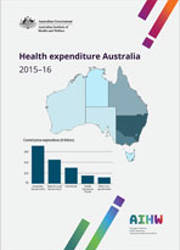Summary
This report provides the latest annual overview of the key trends in health expenditure in Australia. It is the latest in the 33 years of the AIHW’s health expenditure series, and examines health expenditure according to who paid (the source of funds) and the types of health goods and services purchased (area of expenditure) between 2005–06 and 2015–16.
Growth in total health expenditure in Australia continued to be relatively low in 2015–16 compared with the 10-year average. However, this was not the case for all sources of funds and it did not result in a reduction in the ratio of health expenditure to gross domestic product (GDP).
Total health expenditure
Total health expenditure (recurrent and capital expenditure combined) in 2015–16 was $170.4 billion—$6.0 billion (3.6%) higher in real terms than in 2014–15. This was the fourth consecutive year that growth in health expenditure was below the 10-year average (4.7% between 2005–06 and 2015–16).
Growth in real health expenditure per Australian ($7,096 in 2015–16) was also relatively low, at about two-thirds the average annual growth rate over the decade (2.2% compared with 3.0%).
Despite the relatively low growth, the share of the economy (GDP) represented by health (10.3%) increased 0.3 percentage points due to a slower increase in GDP. The increase in the health to GDP ratio was driven more by price rises in the health sector than by the volume of goods and services provided.
Government expenditure
Total government health expenditure ($114.6 billion)—about two-thirds (67.3%) of all health expenditure—grew by 4.1% in real terms in 2015–16. This was lower than the average annual growth rate for the decade (4.4%).
Government expenditure on public hospital services was $46.9 billion (40.9% of total government expenditure) in 2015–16. This was up from $44.3 billion the previous year—a real growth of 5.7%. State and territory expenditure accounted for 52.5% of all sources of expenditure on public hospital services in 2015–16.
In 2015–16, primary health care accounted for almost one-third ($34.6 billion or 30.2%) of all government expenditure—three-quarters of this was Australian Government expenditure (74.0%).
Non-government expenditure
Non-government sources (individuals, private health insurance funds and other non-government sources) spent $55.8 billion on health in 2015–16 (32.7% of total health spending, down from 33.1% the previous year). Growth in non-government expenditure in 2015–16 (2.7%) was half the average annual growth over the decade (5.4%).
Expenditure by individuals accounted for 52.7% of non-government expenditure—down from 53.4% the previous year—and represented 17.3% of total health expenditure, down from 17.7% in 2014–15. In 2015–16, 68.0% of individual expenditure was spent on primary health care and 19.5% of individual expenditure was on dental services.
Preliminary material: Acknowledgments; Abbreviations
1 Introduction
1.1 What is health expenditure?
1.2 The structure of the health sector and its flow of funds
1.3 Structure of this report
2 Health expenditure
2.1 Health expenditure and the GDP
2.2 Health expenditure per person
2.3 Recurrent health expenditure
3 Sources of funds
3.1 Broad trends
3.2 Australian Government expenditure
3.3 State and territory expenditure
3.4 Non-government expenditure
Appendixes
Appendix A: National health expenditure matrixes
Appendix B: State and territory health expenditure matrixes
Appendix C: Data sources and methods
Appendix D: Data quality statement for AIHW health expenditure data—2015–16
End matter: Glossary; References; List of tables; List of figures; List of boxes; Related publications



